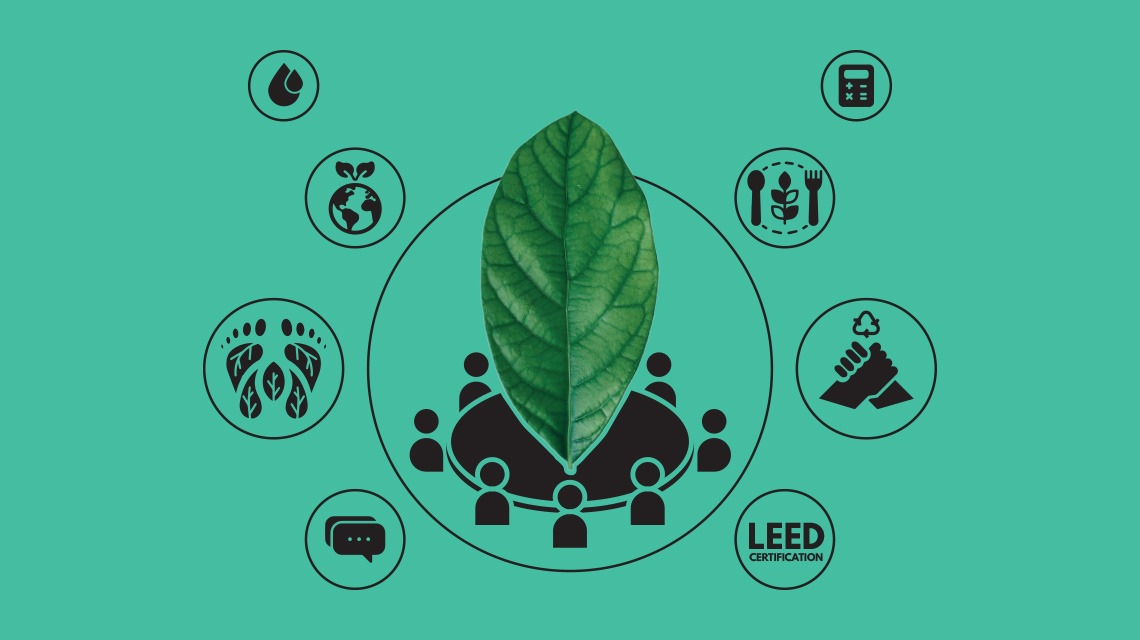Everything you ever wanted to know about planning low-carbon events
As we head into a new calendar year, the biggest question meeting profs are asking about sustainability is no longer why it’s important to be sustainable, but how to actually go about it.
Sustainability is a broad subject—we know this. It’s important to note that sustainability isn’t just about reducing carbon emissions; it’s also about DEI. It’s about helping (and importantly, not harming) the local community. It’s about job security and quality healthcare. When we think of sustainability, though, greenhouse gas emissions are often the first thing to come to mind, and often what attendees are most concerned with.
Many sustainable changes actually overlap to produce positive results in different areas. For example, water conservation benefits our stores of vital natural resources and helps ease hunger around the world. The United Nations Sustainable Development Goals (UN SDGs) are a valuable set of guidelines when it comes to this overlap. Be assured that when you work to reduce carbon emissions, you’re also aiding sustainability in terms of supporting communities, conservation, food security and many other areas.
Greenhouse Gases (GHGs)

Greenhouse gases, or GHGs, are gases that trap heat in the atmosphere, including carbon dioxide (CO2), Methane (CH4), Nitrous Oxide (N2O) and a number of fluorinated gases emitted from a variety of household, commercial and industrial processes.
All greenhouse gases effect the climate to varying degrees based on their abundance, the length of time they remain in the atmosphere and their global warming potential, or GWP (the amount of energy a gas will absorb per one ton, relative to one ton of CO2, during a given period of time)—the higher a gas’ GWP, the more it contributes to warming the earth.
Carbon Emissions

Carbon Dioxide (CO2) is the main greenhouse gas emitted from human activity. CO2 is naturally present in the earth’s atmosphere, but certain activities, primarily the burning of fossil fuels (used for energy and transportation), add more CO2 to the atmosphere and in turn inhibit the abilities of natural elements (or natural sinks), like forests and soils, that remove CO2 from the atmosphere and store it.
Carbon emissions refers to any amount of a carbon compound, usually CO2, that is emitted into the atmosphere. When there is more CO2 in the atmosphere than can be re-absorbed by natural sinks, it becomes part of the net amount of greenhouse gases trapped in the earth’s atmosphere that contribute to warming the earth.
Reducing greenhouse gas emissions (GHG) is a tricky goal to tackle. Emissions and climate change are part of the more technical side of sustainability, so education is vital. Once armed with a basic understanding of the terminology and processes around it, you can begin to identify a clearer path towards making your events greener.
Okay. Let’s break it down.
Events and Carbon Emissions
When Rory G. Archibald, senior business events manager at Visit Scotland, spoke during the fall 2023 Smart Chat Live! webinar, “How to Master the New Green RFP,” he said, “Our industry needs to have a frank conversation about where we are…My personal feeling is that we are still majorly part of the problem. We need to work in partnership with destinations and clients to create the most sustainable events possible.”
The events industry touches many areas that, together, produce high levels of carbon emissions. But let’s frame it this way: planners have the opportunity to make major positive changes. A great place to start is to use carbon accounting—keeping track of the carbon emissions produced throughout every aspect of your event.
Smart Meeting spoke to Heather Griffin, vice president of marketing at Impact XM, to learn about the company’s recent release of seven sustainable action areas that serve as another set of guidelines for planners working towards green events, inspired by the UN SDGs. She explained that using a carbon accounting tool is a big investment and may be too large for just one event, but your partners may already use one of their own.
A venue, for example, can look into the emissions that would be produced by hosting your event in terms of electricity, heating and cooling systems or even on-site catering. All you have to do is ask!
By asking your partners for carbon reporting when you submit your RFP, you can get a sense of how much GHGs your event will emit overall, from the venue to gifting to menus. From there, you can work with all of these partners to cut back and find different ways to do things that will reduce the initially calculated emissions.
Scopes 1, 2 and 3

Scopes separate three different levels of a company’s GHG emissions based on the company’s level of control over the emissions.
Scope 1 emissions are those a company makes or controls directly, like the emissions produced from driving a company car. Scopes 2 and 3 cover emissions that are indirect consequences of a company’s activities but are produced by sources that the company does not directly control.
Scope 2 emissions are those that are produced by wherever companies purchase from, such as the emissions generated by the electricity used to heat or cool a venue that a planner books for an event, during said event (in this way, planners don’t have direct control over how much emissions the venue’s heating and cooling systems produce, but they can reduce their emissions by choosing a venue that uses a type of heating and cooling system that produces lower emissions).
Scope 3 emissions are all those not within a company’s scope 1 and 2 emissions. Scope 3 emissions are those that are created by anything upstream and downstream a company’s value chain; they are also referred to as value chain emissions. This can be anything from emissions produced by employees’ cars while they commute to work to emissions produced by the ways a supplier disposes of their products.
Understanding scopes is a critical part of carbon accounting. When we consider scopes, attendees traveling to attend your event is a scope three emission. You don’t necessarily have control over the emissions produced from this travel, but it is something to include in your carbon accounting. One thing you can do to help reduce emissions from attendee travel is to either locate events near your attendees, so they don’t need to travel as far or can even avoid flying altogether, or coordinate travel with airlines that make efforts to be sustainable, such as those working to incorporate sustainable aviation fuel.
Working with Partners
Those things that are more directly within your control include everything from the venue you choose to the way your catering team sources its food. These factor into your scope two emissions, which, for events, are often the biggest category.
Griffin remembers one instance in which Impact XM sourced a local compost farm to donate used compostable cups after an event. This not only reduced its carbon emissions by reducing the energy it would have taken to process waste from plastic cups, but also supported a local business and, by extension, local peoples’ livelihoods through supporting their jobs. There’s that overlap we talked about earlier!
A LEED-certified venue is an incredible ally in a planner’s sustainability mission, but did you know the entire destination plays a role too? The city of Miami Beach, for one, has established that every single new public project must achieve at least LEED Silver certification. This means by booking one venue and working with the local CVB in a location committed to sustainability, you’re investing money in the entire community, and that investment can be used by the community to further their existing sustainability efforts. Look for destinations that demonstrate a continuing dedication to sustainability in all areas, from supporting a healthy community to efforts to reduce carbon emissions.
LEED Certification

You likely hear “LEED-certified venue” anywhere and everywhere nowadays. But what does it mean, really?
The acronym stands for Leadership in Energy and Environmental Design, and it is the most widely used green building rating system around the world. It was put forward by the U.S. Green Buildings Council in 1998 to provide a set framework for environmentally friendly buildings in all areas, including reduced emissions, conservation of resources, use of sustainable and regenerative materials, protection of biodiversity, enhancement of individual human health and enhancement of the surrounding community’s quality of life.
A building achieves a certain level LEED certification based on prerequisites, credits addressing the many areas listed above and a points system. Certified buildings receive 40-49 points; Silver Certified buildings receive 50-59 points; Gold Certified buildings receive 60-79 points; and Platinum Certified buildings receive over 80 points. There are different rating systems for different types of buildings depending on if it is a new build or major renovation, an existing city building or a single-family home. Almost all hotels, event venues or convention centers would fall under the v.4 BC+D rating (LEED for Building Construction or Design).
The Green Incentive
When it comes to your attendees, the big question is how to let them know your event makes a difference in the global sustainability mission. One way is, of course, by briefing them on what to expect in pre-event emails or by sharing your event’s tracked emissions reduction in an event recap email. Another way is to involve them directly, in real-time—give them an opportunity to collaborate towards reduced emissions, and they’ll be happier for it, knowing they helped make an impact.
Archibald recalled an event that included carbon emissions for each meal on its menus. When guests could see upfront the level of emissions produced from the creation of different menu items, they were far more likely to choose menu items that had lower emissions.
Fagerudd Hotel, in Enköping, Sweden, took this carbon-conscious menu a step further when they established vegetarian-default menus for events. Guests can request meat if they prefer it, yet many guests stick with the vegetarian options due to the hotel’s investment in its chefs and culinary style—the vegetarian meals are as enriching and delicious as the meat-based meals. In 2022, they saved 19 tons of GHG emissions that would have been produced from serving meat-forward menus.
Green All the Way Around
If you’re still not sure where to go from here, consider further education options. EIC offers an SEPC (Sustainable Event Professional Certificate), an interactive, online program of 16 modules that comprehensively educates participants on sustainability’s business value and guides them in developing plans to be more sustainable in their work. Participants earn 12 hours of continuing education credits (CEs) they can apply towards their CMP certification or recertification, or 12 CAE credits, too.
Michelle Moore, senior director of sales and services at Experience Kissimmee, who joined Archibald in the Smart Meetings “How to Master the New Green RFP” webinar, shared, “We know that event organizers have power, and a lot of it. We can really make a difference.”
Meeting organizers have major opportunities to reduce emissions and drive the world’s sustainability mission by taking steps to make their meetings greener. And if planners all take steps to be more sustainable, change on a mass scale is far more possible and positive than it may seem. So, feel empowered that your individual contribution, as a planner, really does make a difference.
This article appears in the January 2024 issue as “Your Complete Guide to Green Meetings.” You can subscribe to the magazine here.





